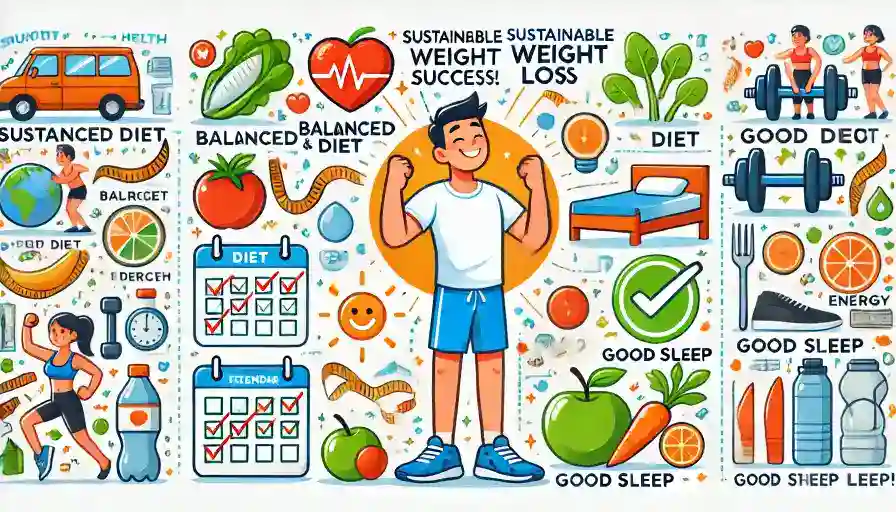Good Strategies for Losing Weight: Effective and Sustainable Methods
Discover good strategies for losing weight, including diet, exercise, sleep, and the power of habit formation, to achieve sustainable weight loss.
Posted by
Related reading
Overcoming Weight Loss Plateaus: Understanding and Solutions
Learn what weight loss plateaus are, why they occur, and discover effective strategies to push past them and achieve your weight loss goals.
Navigating Food Challenges at Work: Tips for a Healthier Office
Explore effective strategies to overcome common food challenges in the workplace and maintain a healthy lifestyle throughout your workday.
Addressing Childhood Obesity: Practical Tips for Families
Explore effective strategies for combating childhood obesity and promoting healthy habits within families.
Finding Your Personal Motivation to Lose Weight
Discover how to identify your personal reasons for losing weight and stay motivated throughout your journey towards a healthier lifestyle.
Healthy Cooking at Home: 6 Strategies for Weight Loss
Discover the key benefits of home cooking and practical tips to make healthy meals that support weight loss goals without sacrificing flavor.

Introduction
People usually think losing weight is about half diet and half exercise, but those two factors combined only account for about 25% of the equation. Another 25% is good quality sleep, and the remaining 50% is actually doing what you said you would. Fortunately, if you start a diet right now, there is a way to make it almost impossible to fail.
Step-by-Step Weight Loss Plan
Step 1: Get Inspired
Inspiration often starts your weight loss journey, usually sparked by seeing someone fit or a photo of yourself. However, inspiration is fleeting and typically lasts just a day. To sustain this initial burst of motivation, find what drives you personally. Maybe it’s fitting into an old pair of jeans, improving your health, or preparing for an event. Whatever it is, hold onto that vision and use it as a daily reminder of why you started this journey.
Step 2: Set Realistic Goals
You need a measurable and time-bound goal to stay motivated. For example, aim to lose 5 pounds by a specific date. Breaking down larger goals into smaller, more manageable ones can make the process less overwhelming and provide frequent opportunities to celebrate progress.
Consider setting both short-term and long-term goals. Short-term goals could be something like "I will walk 10,000 steps every day for the next week," while long-term goals might include "I want to lose 30 pounds in the next six months." Having these milestones helps keep you focused and motivated over time.
Step 3: Create a Detailed Plan
Develop a realistic plan to achieve your goals. For instance, replace your high-calorie breakfast with a healthy alternative like a 1-mile jog, a bowl of strawberries, and boiled eggs. This change alone can lead to significant weight loss in a few weeks.
Step 4: Prepare for Success
Set yourself up for success by preparing the night before. Have your healthy foods ready and ensure your environment supports your goals. If unhealthy foods are easily accessible, it indicates a lack of commitment to your diet. Clear out the junk food from your pantry and replace it with healthier options. Preparation is key; cook meals in advance and keep healthy snacks handy to avoid the temptation of quick, unhealthy options.
Step 5: Anticipate Challenges
Expect hard times and plan for them. Build your willpower by practicing saying no to temptations. Avoid situations where you might be tempted, but also recognize that willpower isn’t infinite. Developing strategies to manage cravings and deal with potential setbacks will help you stay on track. Remember, it’s not about never indulging but about finding a balance and making healthier choices most of the time.
Step 6: Build Habits
Consistency is key. Doing something long enough for it to become a habit makes it significantly easier to stick to your plan. If you can wake up and automatically follow your healthy routine, maintaining your weight loss efforts will become second nature. Habits reduce the mental effort required to make healthy choices, turning them into automatic behaviors.
Tracking Progress
Use Progress Pictures and Weigh-Ins
The most accurate way to track fat loss is through progress pictures and weekly weigh-ins. Visual progress might take time to show, so be patient. Regularly reviewing these can help you see changes that the scale might not show. Take photos from different angles and in the same outfit to get a clear comparison over time.
Monitor Caloric Intake
To lose fat, you need to consume fewer calories than you burn. Start with an online calorie calculator and adjust based on your progress. Be mindful that everyone's metabolism is different, and hormonal issues can affect weight loss. Keeping a food diary can help you stay accountable and aware of what you’re consuming. Apps like MyFitnessPal or Lose It! make tracking easier by providing a vast database of foods and their nutritional content.
Dietary Tips
Focus on Whole Foods
Slowly incorporate more minimally processed foods like fruits, vegetables, lean proteins, and whole grains into your diet. These foods are filling and help maintain a calorie deficit without feeling constantly hungry. Whole foods are rich in nutrients that your body needs to function properly, and they help keep you satisfied longer compared to processed foods.
Avoid Snacking
Cutting out snacks, especially high-calorie junk food, can significantly reduce your daily calorie intake. Drink water to stay hydrated and avoid high-calorie beverages. If you do need a snack, opt for healthier choices like a piece of fruit, a handful of nuts, or some raw veggies with hummus.
High Volume, Low-Calorie Foods
Eating foods high in volume and low in calories can help you feel full while staying within your calorie limit. Foods like leafy greens, berries, and broth-based soups can be consumed in larger quantities without adding many calories.
Enjoy Healthy Foods
To lose weight, you need to lower the total calories you take in from food and drinks. But your meals can still be tasty and simple to make. One way to take in fewer calories is to eat more fruits, vegetables, and whole grains. These are known as plant-based foods. They're low in calories and high in fiber, which helps you feel full.
Follow these other diet tips too:
- Eat at least four servings of vegetables and three servings of fruits a day.
- Snack on fruits and veggies if you get hungry between meals.
- Have whole grains, such as brown rice, barley, and whole-wheat bread and pasta.
- Eat fewer refined grains, such as white rice and white bread.
- Use healthy fats, such as olive oil, vegetable oils, avocados, nuts, nut butters, and nut oils. But keep in mind that even healthy fats are high in calories.
- Limit foods and drinks that have added sugar. These include desserts, jellies, and sodas. The natural sugar in fruit is OK.
- Choose low-fat or fat-free dairy products.
- Focus on eating fresh foods. They have more nutrition than processed foods, which often come in a box or a can and tend to have more fat, sugar, or salt.
It's also a good idea to be mindful while you eat. Focus on each bite of food. This helps you enjoy the taste and makes you more aware of when you feel full. Try not to watch TV or stare at your phone during meals, as this can lead to overeating without realizing it.
Exercise Tips
Lift Weights
Weight lifting increases metabolism, burns calories, and builds muscle. Strength training exercises, like lifting weights or using resistance bands, should be done at least twice a week. Building muscle mass helps increase your resting metabolic rate, meaning you burn more calories even when you're not actively exercising.
Increase Daily Activity
Incorporate more walking and general movement into your day to burn extra calories. Take the stairs, park farther away from your destination, and find small ways to stay active throughout the day. Even activities like gardening, cleaning the house, or playing with your kids can contribute to your daily calorie burn.
Cardio
Cardio exercises help burn calories and improve overall health. Consider high-intensity interval training (HIIT) or circuit workouts if traditional cardio feels monotonous. HIIT involves short bursts of intense exercise followed by rest or low-intensity periods, which can be more effective for fat loss and improving cardiovascular fitness.
Enjoy Physical Activity
You can lose weight without exercise, but it's harder to do. Regular physical activity helps burn off extra calories. Exercise has many other benefits as well: it can lift your mood, lower blood pressure, and help you sleep better. Exercise also helps you keep off the weight that you lose. Studies show that people who maintain their weight loss over the long term get regular physical activity.
How many calories you burn depends on how often, how long, and how hard you exercise. One of the best ways to lose body fat is through steady aerobic exercise, such as brisk walking. Work up to at least 30 minutes of aerobic exercise most days of the week. Some people may need more exercise than this to lose weight and keep it off.
Also, aim to do strength training exercises at least twice a week. You could lift weights, use exercise bands, or do pushups. Any extra movement helps you burn calories, so think about ways to move more during the day. You could:
- Use the stairs instead of an elevator.
- Park at the far end of the lot when you shop.
- Stand instead of sit while you talk on the phone or check email.
- Walk laps around the room or march in place while you watch TV.
Importance of Sleep
Quality Sleep
Quality sleep regulates hormones crucial for fat loss. Ensure you get enough rest to support your weight loss journey. Aim for 7-9 hours of sleep per night to help your body recover and function optimally. Poor sleep can lead to weight gain by affecting your hunger hormones, making you more likely to overeat and choose unhealthy foods.
Develop a Sleep Routine
Create a bedtime routine to improve sleep quality. Go to bed and wake up at the same time every day, even on weekends. Avoid screens for at least an hour before bed, as the blue light emitted can interfere with your sleep cycle. Instead, engage in relaxing activities like reading, meditation, or taking a warm bath.
Additional Tips for Sustainable Weight Loss
Mindful Eating
Focus on each bite of food to enjoy the taste and recognize when you feel full. Avoid distractions like TV or your phone during meals to prevent overeating. Mindful eating helps you appreciate your food more and can prevent emotional eating.
Social Support
Surround yourself with supportive friends and family who encourage your weight loss journey. Share your goals and progress with them to stay motivated and accountable. Having a support system can provide encouragement during challenging times and help you celebrate your successes.
Plan Ahead
Prepare your meals and snacks in advance to avoid unhealthy choices. Keep healthy foods readily available and plan your meals around whole, nutritious ingredients. Meal planning and prepping can save you time and ensure you always have healthy options on hand.
Stay Positive
Weight loss is a gradual process. Stay patient and persistent, and don’t be discouraged by setbacks. Focus on making lasting lifestyle changes for long-term success. It's important to remember that perfection isn't the goal—consistency is. Celebrate your progress, no matter how small, and keep moving forward.
Find Activities You Enjoy
The best exercise is the one you enjoy and can stick with. Try different activities to see what you like best. Whether it's dancing, swimming, hiking, or yoga, finding a physical activity you enjoy will make it easier to stay active consistently.
Keep Learning
Stay informed about nutrition and fitness. Read books, watch videos, or follow reputable health and fitness experts. The more you know, the better equipped you'll be to make healthy choices and stay motivated.
Reward Yourself
Set up a reward system for reaching your goals. It doesn't have to be food-related—consider treating yourself to a new outfit, a massage, or a fun outing. Rewards can provide extra motivation and make the process more enjoyable.
By following these good strategies for losing weight, you can set yourself up for successful and sustainable weight loss. Remember, the key to lasting change is consistency and commitment to a healthier lifestyle. With the right mindset, preparation, and support, you can achieve your weight loss goals and maintain a healthier, happier you.
Other Interesting Articles

Unlocking Satiety: The Power of Protein and Fiber for Lasting Fullness
Explore how protein and fiber in your meals can profoundly affect your satiety levels, helping you feel fuller for longer and support your wellness journey.

Understanding Carb Cycling: Benefits, Risks, and Sample Menus
Explore the concept of carb cycling, its potential benefits, risks, and sample meal plans to see if this trend fits your wellness journey.

How Alcohol Affects Abdominal Fat: Tips for a Healthier Lifestyle
Explore how alcohol contributes to abdominal fat gain and discover effective strategies to enjoy your favorite drinks while maintaining a healthier waistline.

The Transformative Power of Exercise: Benefits for Body and Mind
Unlock the myriad benefits of exercise for your physical and mental well-being, from improved mood to better immune function and lasting habits.